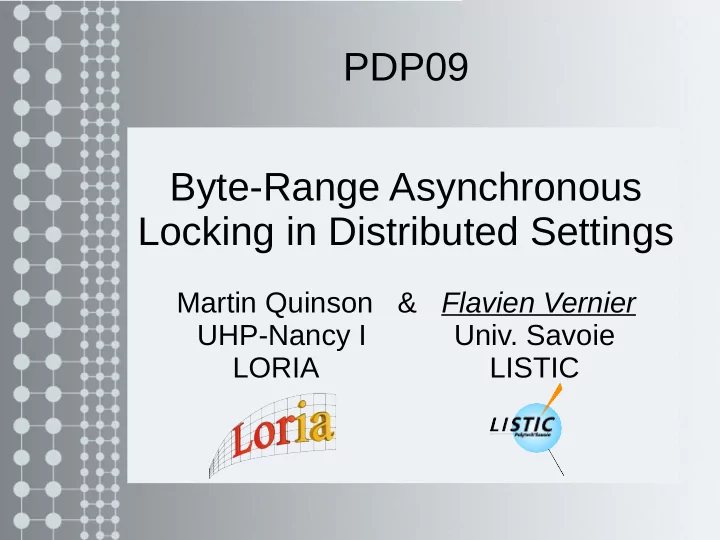

PDP09 Byte-Range Asynchronous Locking in Distributed Settings Martin Quinson & Flavien Vernier UHP-Nancy I Univ. Savoie LORIA LISTIC
Context & Objectives ● Context – Mutual exclusion algorithms – Large scale distributed systems – Large resource ● Objectives – Request partialy a critical section – Asynchronous range locks 19 February 2009 PDP 2009 2
Contents ● Asynchronous Range Locking ● Naimi-Trehel Algorithm ● Split Waiting Queues (SWQ) algorithm – The algorithm – A use case ● Experiments – Comparison between: classical Naimi-Trehel, centralized and SWQ algorithms ● Conclusion & Future works 19 February 2009 PDP 2009 3
Asynchronous Ranged Locking ● Asynchronous Range Locking is the ability to: – Partially lock a resource, – not be blocked by the request of a lock. ● It is very useful: – if the access to the resource can be predicted, – to continue to work until access to the resource. ● This approach is particularly adapted to distributed systems and large resource. 19 February 2009 PDP 2009 4
Asynchronous Ranged Locking ● Interface: – lockCreate: range → lockId – lockTest: lockId → bool – doLock: lockId → data – unLock: lockId x data → null Application Application Application Interface Interface Interface Distributed mutual exclusion manager (NT, Central, SWQ...) 19 February 2009 PDP 2009 5
Naimi-Trehel Algorithm ● Naimi-Trehel algorithm can be split in two parts: – The token request ● owner (peer): the 'supposed' owner ● request (bool): true if the node requests the token. – The token exchange ● token (bool): true if the node has the token. ● next (peer): the peer to which the token must be sent. ● These two parts are strongly linked 19 February 2009 PDP 2009 6
Split Waiting Queues (SWQ) algorithm ● SWQ algorithm uses the same principles as Naimi-Trehel algorithm. ● SWQ algorithm introduces a new concept in Naimi-Trehel algorithm: – The token can be split in sub-tokens. – The sub-tokens are tokens. – Two contiguous tokens can be merged in only one token. ● A token is a contiguous range. 19 February 2009 PDP 2009 7
Split Waiting Queues (SWQ) algorithm ● To manage the multi-tokens the information stored by Naimi-Trehel algorithm are modified: – owners (list of peers): the list of 'supposed' owners – owned (list of tokens): the stored tokens – request (range): the requested token. – nexts (list of peer-token): the peers to which the tokens should be sent. 19 February 2009 PDP 2009 8
Split Waiting Queues (SWQ) algorithm ● To avoid conflicts or dead locks: – two supplementary lists must be managed: ● requestingReceived (list of tokens): sub- tokens of the request already received ● waitingRequests (list of requests): the requests that conflict with its own request. – a request is always proceeded sequentially, – a request message contains the requested range and the already found range, – A node becomes the owner of a part only when its request finds this part. 19 February 2009 PDP 2009 9
Split Waiting Queues (SWQ) algorithm: illustration ● Initial configuration: 1 1 [0..9] 0 0 [0..9] [0..9] 2 3 2 3 19 February 2009 PDP 2009 10
Split Waiting Queues (SWQ) algorithm: illustration ● Node 1 requests [0..2]: 1 1 [3..9] [0..2] [0..2] 0 0 [0..9] [0..9] 2 3 2 3 19 February 2009 PDP 2009 11
Split Waiting Queues (SWQ) algorithm: illustration ● Node 2 requests [2..3]: 1 1 [3..9] [0..2] [0..2] 0 0 [0..9] [0..9] 2 3 2 3 19 February 2009 PDP 2009 12
Split Waiting Queues (SWQ) algorithm: illustration ● Node 2 requests [2..3]: 1 1 [3..9] [0..2] [0..2] [2..2] 0 0 [2..2] [0..1][3..9] [0..9] 2 3 2 3 19 February 2009 PDP 2009 13
Split Waiting Queues (SWQ) algorithm: illustration ● Node 2 requests [2..3]: 1 1 [3..9] [0..1] [0..2] [2..2] 0 0 [2..2] [0.1][4..9] [0..9] [3..3] 2 3 2 3 [2..3] 19 February 2009 PDP 2009 14
Experimentations ● The experiments are realized with the GRAS API of SimGrid Simulator. ● Each node requests 25 locks. ● The parameters used are: – alpha: the time each lock is kept by nodes, – the number of nodes, – the size of the resource, – the size of requested range. 19 February 2009 PDP 2009 15
Experimentations: first comparison ● The resource size is fixed to 64kb. # of nodes alpha range algo 2 12 22 42 82 162 central 0.2 1.6 3.6 7.6 16.3 33.5 1/16 SWQ 0.3 3 5 11 32.6 117 NT 0.8 13.1 23.4 44.7 82.6 165 0.25 central 1 19.1 37.8 70.2 138 277 full SWQ 0.9 26.6 72.1 228 745 2807 central 0.6 5.1 9.7 18.9 37.2 73.1 1/16 SWQ 0.6 6.2 13.1 31.3 60.9 153 NT 4.5 64.8 122 237 463 922 5 full central 5.7 71.7 137 264 520 1035 SWQ 4.5 64.8 122 268 787 2860 19 February 2009 PDP 2009 16
Experimentations: Impact of resource size ● Range fixed to 1/16 # of nodes size alpha algo 2 12 22 42 82 162 central 0,4 5,3 11,5 21,8 43,9 86,4 0.25 SWQ 0,5 4,3 6,4 14,2 36 124 640kb central 0,7 7 13,4 24,4 47,7 92,9 5 SWQ 0,7 7,3 14 32,3 66,4 151 central 4.9 48.2 92.8 165 318 618 0.25 SWQ 2.6 21 27.1 50.8 91.8 199 6.25Mb central 4.9 46 88.7 159 312 618 5 SWQ 2.6 19.9 30.3 66 113 240 19 February 2009 PDP 2009 17
Conclusion & Future works ● A new distributed mutual exclusion algorithm adapted to distributed system and large resource is introduced: – It allows partial locks, – It has not central point, – It allows asynchronous lock. ● The main future works will consist in: – comparing the simulation results to live deployements, – relaxing some constraints to improve the performances 19 February 2009 PDP 2009 18
Recommend
More recommend